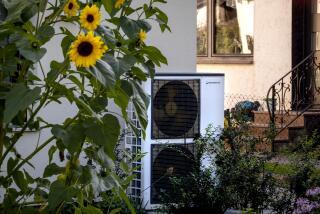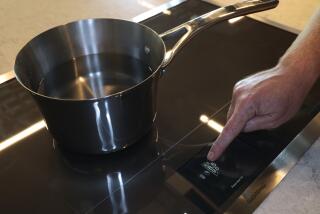Pumping Heat: A Way to Keep Cool
- Share via
The first time you hear someone mention a heat pump, you’re likely to do a double-take.
It’s the sort of thing that sounds reasonable if it’s said fast--but then you find yourself with a mental vision of working a handle up and down to pump a couple of gallons of heat over a can of beans for lunch.
both in residences and in commercial or industrial buildings. Most of those in use heat or cool by utilizing the difference in temperature between the air inside and outside the building.
However, a Southland firm is utilizing the temperature difference between the air in a home and the ground beneath it to do the job. Bahler Hydrothermal Co., 253 N. Alta Vista Ave., Monrovia 91016, has been installing earth-coupled heat pumps for several years.
The installation consists of one or more pairs of polyethylene pipes run straight down into the earth and connected at the bottom. The wells are 50 to sometimes more than 200 feet deep.
The pipes are filled with water that circulates continuously from the heat pump in the house down into the earth, whose constant temperature at that depth cools it to about 70 degrees, then back up and through the heat pump. The pump uses a radiator-like heat exchanger to transfer heat from the house’s air to the water, which carries the heat away and dissipates it into the ground. The cooled air is then used to cool the house.
“The house is my heat source and the ground is my heat sink,” Bahler President Robert M. Mendoza explained. “For heating in the winter, that’s reversed--the earth is my heat source and the house is my heat sink.” Cooler air from the house is warmed by water from the earth.
It doesn’t seem to stand to reason that air could be warmed in the cold earth but the secret is that what counts isn’t the actual temperatures but the difference in the temperatures. Short of absolute zero, any air, water or earth has some heat in it and that is extracted by the heat pump for use or for discard.
One of his recent installations is in the 2,900-square-foot, two-story Woodland Hills home of the Stephen Gregorchuks, which has a 6 1/2-ton system that uses three two-pipe circuits. The wells were dug and the pipes installed first, then the house was built over them; the heat pump is in a cabinet in the attached garage, right alongside the conventional water heater, so nothing is exposed.
Kim Gregorchuk told a visitor that an exact before-and-after cost comparison was impossible because of certain complications but a Department of Water & Power inspector performed an energy audit and told her their bills “would be two-thirds higher without the (Bahler heat-pump) system.”
Another house, in Calabasas Highlands, is all-electric except for a gas water heater; everything else in the 3,200-square-foot home, including cooking and the swimming-pool pump, works by electricity. The total electric bill for the month from May 23 to June 21 was $65.95.
The cost of the Bahler system is about $1,500 a ton but that is currently offset to a great extent by state and federal energy credits, and Mendoza emphasized the minimal operating cost. Furthermore, the system receives “bonus points” under state energy conservation legislation, allowing the Gregorchuks 20% window area rather than the basic 16%.
Mendoza began working with heat pumps in Covington, Ky., near Cincinnati. The firm installed them in Indiana, the St. Louis area and Hastings, Mich., near Grand Rapids, where they heated homes from groundwater at 55 degrees.
He came to Southern California in 1980 and formed the Bahler firm with two partners, Albert Mercado, who does the refrigeration work, and Michael Lindsay, who does the plumbing, ducting and structural modifications. Mendoza’s part is the engineering and thermodynamics.
Since 1980, they have installed about 200 heat-pump systems, including a number in Riverside County, principally in the Glen Avon area, and the San Fernando Valley, including Calabasas, Woodland Hills, Sepulveda and Northridge.
To understand, very basically, how a heat pump works, think of your refrigerator. It is an insulated box to store food. The heat in the food and in the air around it is trapped and moved outside the refrigerator by alternately evaporating and condensing freon.
When the inside of the box is cooled, the machinery shuts off, but as the door is opened and closed, warm food is put in and heat trickles through even the best insulation, the inside of the box warms up and the machinery kicks back on long enough to cool things down again.
Theoretically, you could build your refrigerator into a wall so that the door is in the room and the coils that dissipate the heat are outside. They you could just open the door and the refrigerator would suck heat from the room and dump it outside.
Practically, that would be very inefficient and horrendously expensive. But a refrigerator can be designed, not to keep food cold, but to move heat out of a room (or into it) and to do it efficiently; that “refrigerator” is a heat pump. It doesn’t look anything at all like your kitchen refrigerator but the principle is the same.
A good book on the subject is “Heat Pumps: An Efficient Heating & Cooling Alternative” by Dermot McGuigan with Amanda McGuigan, published by Garden Way Publishing, Charlotte, Vt. 05445. Authoritative and easy to read, it covers the subject admirably.
More to Read
Sign up for Essential California
The most important California stories and recommendations in your inbox every morning.
You may occasionally receive promotional content from the Los Angeles Times.













